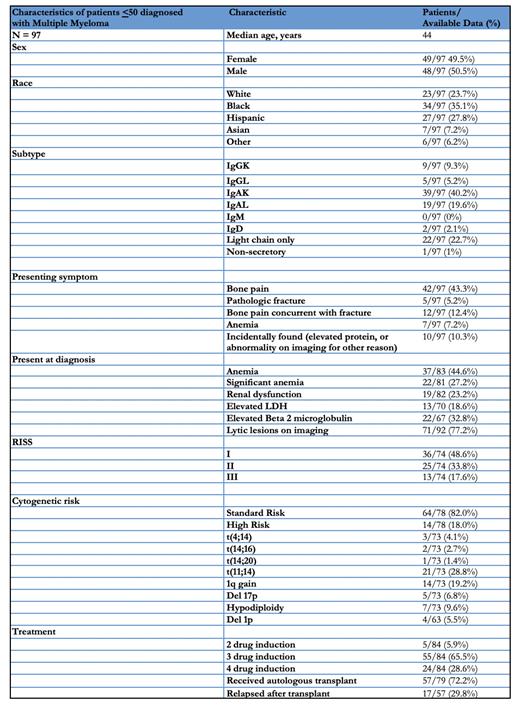Introduction: Multiple Myeloma (MM) presents at a median age of 69. Patients age 50 or younger represent only 10% of diagnoses and are less well-characterized. Some studies have suggested that younger MM patients are more likely to present with lytic lesions, be IgD subtype, have high-risk cytogenetics, and have relatively improved survival. We aimed to characterize this understudied population in the modern era.
Methods: We conducted a retrospective chart review of patients age <50 meeting IMWG criteria for symptomatic MM treated across our institution's cancer center network between 2010 and 2023. Overall survival was defined as time in months from diagnosis to last follow-up or death. Time to relapse after transplant was captured.
Results: We identified 97 younger MM patients, with a median age of 44 (range 26-50). Males and females represented 50.5% and 49.5% of cases respectively. Complete demographics are listed in the table. The most common MM subtype was IgG Kappa (40%), and 23% had light chain-only disease. Incidentally found cases, defined as abnormalities on imaging or labs ordered for another reason, represented 11% of cases. 61% of patients presented with a skeletal issue such as bone pain and/or pathologic fracture. Presenting features are described in the table. At time of diagnosis, 77% of patients were found to have lytic lesions. Few patients had previously identified MGUS (3%) or smoldering MM (5%). Regarding cytogenetics, 18% had one or more high-risk features. The most common frontline treatment was VRD. As shown in the table, 66% and 29% received 3 and 4 drug induction regimens respectively. Of note, 91% were referred for autologous stem cell transplant (ASCT), and 72% proceeded. 4 patients were deceased at the time of analysis. Survival for the entire population was 95.9% at a median follow up time of 65.5 months. In the patients who underwent ASCT, 41.2% relapsed with median progression-free survival of 57 (44-71) months.
Conclusions: MM patients age <50 were found to be distinct from the known characteristics of the general population in several notable ways. There was equipoise among demographic features, with a nearly equivalent prevalence in males and females, and similar median ages across racial groups. We found a greater enrichment of light chain disease than expected, but less renal dysfunction at presentation. IgD subtype does not appear increased in this population. Younger patients do not appear more likely to have high risk cytogenetics. Lastly, survival for younger patients was higher compared to the reported 5-year survival of MM, which may be explained by the finding that these patients were treated primarily with triplet or quadruplet anti-myeloma regimens and often proceeded to ASCT.
Disclosures
Davies:Amgen: Membership on an entity's Board of Directors or advisory committees; Janssen: Membership on an entity's Board of Directors or advisory committees; BMS / Celgene: Membership on an entity's Board of Directors or advisory committees; Regeneron: Membership on an entity's Board of Directors or advisory committees; pfizer: Membership on an entity's Board of Directors or advisory committees; sanofi: Membership on an entity's Board of Directors or advisory committees; Takeda: Membership on an entity's Board of Directors or advisory committees. Braunstein:Epizyme: Consultancy, Honoraria; BMS: Consultancy, Honoraria; CTI Biopharma: Consultancy, Honoraria; Seagen: Consultancy, Honoraria; Abbvie: Consultancy, Honoraria; Janssen: Consultancy, Honoraria, Speakers Bureau; Adaptive biosciences: Consultancy, Honoraria; Guidepoint: Consultancy, Honoraria; Pfizer: Consultancy, Honoraria; GSK: Consultancy, Honoraria; ADC Therapeutics: Consultancy, Honoraria; Sanofi: Consultancy, Honoraria.


This feature is available to Subscribers Only
Sign In or Create an Account Close Modal